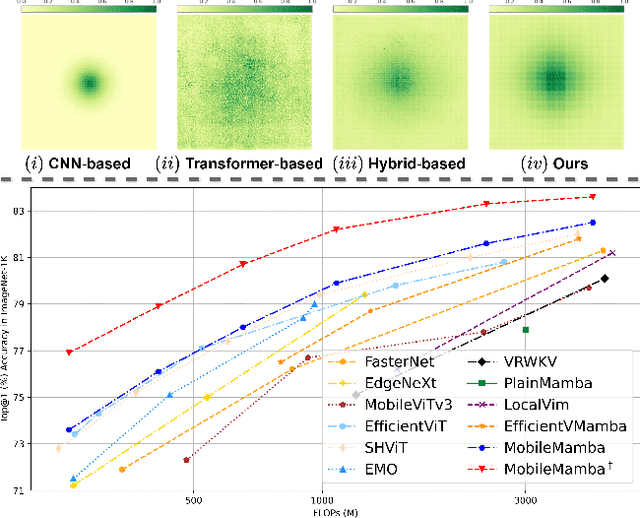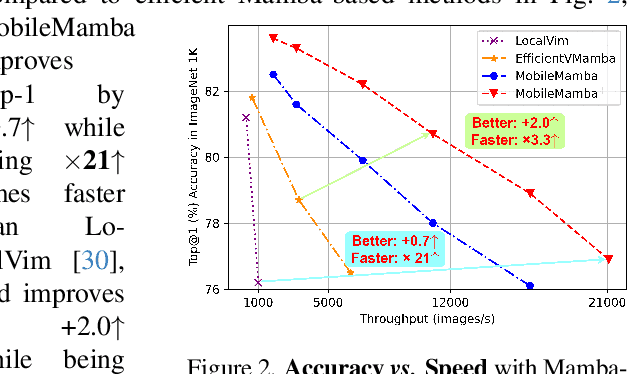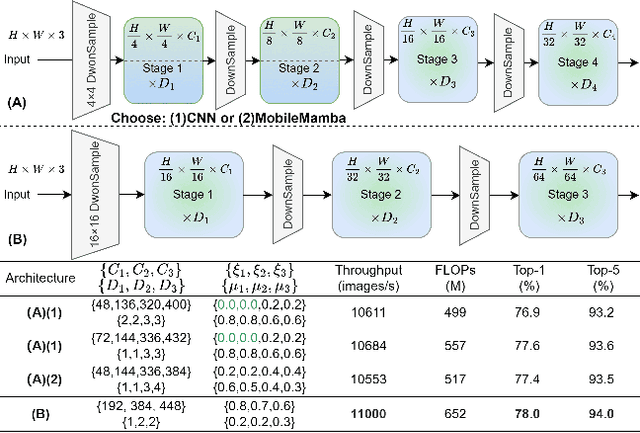Haoyang He
UltraVideo: High-Quality UHD Video Dataset with Comprehensive Captions
Jun 16, 2025Abstract:The quality of the video dataset (image quality, resolution, and fine-grained caption) greatly influences the performance of the video generation model. The growing demand for video applications sets higher requirements for high-quality video generation models. For example, the generation of movie-level Ultra-High Definition (UHD) videos and the creation of 4K short video content. However, the existing public datasets cannot support related research and applications. In this paper, we first propose a high-quality open-sourced UHD-4K (22.4\% of which are 8K) text-to-video dataset named UltraVideo, which contains a wide range of topics (more than 100 kinds), and each video has 9 structured captions with one summarized caption (average of 824 words). Specifically, we carefully design a highly automated curation process with four stages to obtain the final high-quality dataset: \textit{i)} collection of diverse and high-quality video clips. \textit{ii)} statistical data filtering. \textit{iii)} model-based data purification. \textit{iv)} generation of comprehensive, structured captions. In addition, we expand Wan to UltraWan-1K/-4K, which can natively generate high-quality 1K/4K videos with more consistent text controllability, demonstrating the effectiveness of our data curation.We believe that this work can make a significant contribution to future research on UHD video generation. UltraVideo dataset and UltraWan models are available at https://xzc-zju.github.io/projects/UltraVideo.
FinanceReasoning: Benchmarking Financial Numerical Reasoning More Credible, Comprehensive and Challenging
Jun 06, 2025Abstract:We introduce FinanceReasoning, a novel benchmark designed to evaluate the reasoning capabilities of large reasoning models (LRMs) in financial numerical reasoning problems. Compared to existing benchmarks, our work provides three key advancements. (1) Credibility: We update 15.6% of the questions from four public datasets, annotating 908 new questions with detailed Python solutions and rigorously refining evaluation standards. This enables an accurate assessment of the reasoning improvements of LRMs. (2) Comprehensiveness: FinanceReasoning covers 67.8% of financial concepts and formulas, significantly surpassing existing datasets. Additionally, we construct 3,133 Python-formatted functions, which enhances LRMs' financial reasoning capabilities through refined knowledge (e.g., 83.2% $\rightarrow$ 91.6% for GPT-4o). (3) Challenge: Models are required to apply multiple financial formulas for precise numerical reasoning on 238 Hard problems. The best-performing model (i.e., OpenAI o1 with PoT) achieves 89.1% accuracy, yet LRMs still face challenges in numerical precision. We demonstrate that combining Reasoner and Programmer models can effectively enhance LRMs' performance (e.g., 83.2% $\rightarrow$ 87.8% for DeepSeek-R1). Our work paves the way for future research on evaluating and improving LRMs in domain-specific complex reasoning tasks.
RayFronts: Open-Set Semantic Ray Frontiers for Online Scene Understanding and Exploration
Apr 09, 2025Abstract:Open-set semantic mapping is crucial for open-world robots. Current mapping approaches either are limited by the depth range or only map beyond-range entities in constrained settings, where overall they fail to combine within-range and beyond-range observations. Furthermore, these methods make a trade-off between fine-grained semantics and efficiency. We introduce RayFronts, a unified representation that enables both dense and beyond-range efficient semantic mapping. RayFronts encodes task-agnostic open-set semantics to both in-range voxels and beyond-range rays encoded at map boundaries, empowering the robot to reduce search volumes significantly and make informed decisions both within & beyond sensory range, while running at 8.84 Hz on an Orin AGX. Benchmarking the within-range semantics shows that RayFronts's fine-grained image encoding provides 1.34x zero-shot 3D semantic segmentation performance while improving throughput by 16.5x. Traditionally, online mapping performance is entangled with other system components, complicating evaluation. We propose a planner-agnostic evaluation framework that captures the utility for online beyond-range search and exploration, and show RayFronts reduces search volume 2.2x more efficiently than the closest online baselines.
EMOv2: Pushing 5M Vision Model Frontier
Dec 09, 2024



Abstract:This work focuses on developing parameter-efficient and lightweight models for dense predictions while trading off parameters, FLOPs, and performance. Our goal is to set up the new frontier of the 5M magnitude lightweight model on various downstream tasks. Inverted Residual Block (IRB) serves as the infrastructure for lightweight CNNs, but no counterparts have been recognized by attention-based design. Our work rethinks the lightweight infrastructure of efficient IRB and practical components in Transformer from a unified perspective, extending CNN-based IRB to attention-based models and abstracting a one-residual Meta Mobile Block (MMBlock) for lightweight model design. Following neat but effective design criterion, we deduce a modern Improved Inverted Residual Mobile Block (i2RMB) and improve a hierarchical Efficient MOdel (EMOv2) with no elaborate complex structures. Considering the imperceptible latency for mobile users when downloading models under 4G/5G bandwidth and ensuring model performance, we investigate the performance upper limit of lightweight models with a magnitude of 5M. Extensive experiments on various vision recognition, dense prediction, and image generation tasks demonstrate the superiority of our EMOv2 over state-of-the-art methods, e.g., EMOv2-1M/2M/5M achieve 72.3, 75.8, and 79.4 Top-1 that surpass equal-order CNN-/Attention-based models significantly. At the same time, EMOv2-5M equipped RetinaNet achieves 41.5 mAP for object detection tasks that surpasses the previous EMO-5M by +2.6. When employing the more robust training recipe, our EMOv2-5M eventually achieves 82.9 Top-1 accuracy, which elevates the performance of 5M magnitude models to a new level. Code is available at https://github.com/zhangzjn/EMOv2.
MobileMamba: Lightweight Multi-Receptive Visual Mamba Network
Nov 24, 2024



Abstract:Previous research on lightweight models has primarily focused on CNNs and Transformer-based designs. CNNs, with their local receptive fields, struggle to capture long-range dependencies, while Transformers, despite their global modeling capabilities, are limited by quadratic computational complexity in high-resolution scenarios. Recently, state-space models have gained popularity in the visual domain due to their linear computational complexity. Despite their low FLOPs, current lightweight Mamba-based models exhibit suboptimal throughput. In this work, we propose the MobileMamba framework, which balances efficiency and performance. We design a three-stage network to enhance inference speed significantly. At a fine-grained level, we introduce the Multi-Receptive Field Feature Interaction(MRFFI) module, comprising the Long-Range Wavelet Transform-Enhanced Mamba(WTE-Mamba), Efficient Multi-Kernel Depthwise Convolution(MK-DeConv), and Eliminate Redundant Identity components. This module integrates multi-receptive field information and enhances high-frequency detail extraction. Additionally, we employ training and testing strategies to further improve performance and efficiency. MobileMamba achieves up to 83.6% on Top-1, surpassing existing state-of-the-art methods which is maximum x21 faster than LocalVim on GPU. Extensive experiments on high-resolution downstream tasks demonstrate that MobileMamba surpasses current efficient models, achieving an optimal balance between speed and accuracy.
LLaVA-KD: A Framework of Distilling Multimodal Large Language Models
Oct 21, 2024Abstract:The success of Large Language Models (LLM) has led researchers to explore Multimodal Large Language Models (MLLM) for unified visual and linguistic understanding. However, the increasing model size and computational complexity of MLLM limit their use in resource-constrained environments. Small-scale MLLM (s-MLLM) aims to retain the capabilities of the large-scale model (l-MLLM) while reducing computational demands, but resulting in a significant decline in performance. To address the aforementioned issues, we propose a novel LLaVA-KD framework to transfer knowledge from l-MLLM to s-MLLM. Specifically, we introduce Multimodal Distillation (MDist) to minimize the divergence between the visual-textual output distributions of l-MLLM and s-MLLM, and Relation Distillation (RDist) to transfer l-MLLM's ability to model correlations between visual features. Additionally, we propose a three-stage training scheme to fully exploit the potential of s-MLLM: 1) Distilled Pre-Training to align visual-textual representations, 2) Supervised Fine-Tuning to equip the model with multimodal understanding, and 3) Distilled Fine-Tuning to further transfer l-MLLM capabilities. Our approach significantly improves performance without altering the small model's architecture. Extensive experiments and ablation studies validate the effectiveness of each proposed component. Code will be available at https://github.com/caiyuxuan1120/LLaVA-KD.
Learning Multi-view Anomaly Detection
Jul 16, 2024



Abstract:This study explores the recently proposed challenging multi-view Anomaly Detection (AD) task. Single-view tasks would encounter blind spots from other perspectives, resulting in inaccuracies in sample-level prediction. Therefore, we introduce the \textbf{M}ulti-\textbf{V}iew \textbf{A}nomaly \textbf{D}etection (\textbf{MVAD}) framework, which learns and integrates features from multi-views. Specifically, we proposed a \textbf{M}ulti-\textbf{V}iew \textbf{A}daptive \textbf{S}election (\textbf{MVAS}) algorithm for feature learning and fusion across multiple views. The feature maps are divided into neighbourhood attention windows to calculate a semantic correlation matrix between single-view windows and all other views, which is a conducted attention mechanism for each single-view window and the top-K most correlated multi-view windows. Adjusting the window sizes and top-K can minimise the computational complexity to linear. Extensive experiments on the Real-IAD dataset for cross-setting (multi/single-class) validate the effectiveness of our approach, achieving state-of-the-art performance among sample \textbf{4.1\%}$\uparrow$/ image \textbf{5.6\%}$\uparrow$/pixel \textbf{6.7\%}$\uparrow$ levels with a total of ten metrics with only \textbf{18M} parameters and fewer GPU memory and training time.
ADer: A Comprehensive Benchmark for Multi-class Visual Anomaly Detection
Jun 06, 2024Abstract:Visual anomaly detection aims to identify anomalous regions in images through unsupervised learning paradigms, with increasing application demand and value in fields such as industrial inspection and medical lesion detection. Despite significant progress in recent years, there is a lack of comprehensive benchmarks to adequately evaluate the performance of various mainstream methods across different datasets under the practical multi-class setting. The absence of standardized experimental setups can lead to potential biases in training epochs, resolution, and metric results, resulting in erroneous conclusions. This paper addresses this issue by proposing a comprehensive visual anomaly detection benchmark, \textbf{\textit{ADer}}, which is a modular framework that is highly extensible for new methods. The benchmark includes multiple datasets from industrial and medical domains, implementing fifteen state-of-the-art methods and nine comprehensive metrics. Additionally, we have open-sourced the GPU-assisted \href{https://pypi.org/project/ADEval}{ADEval} package to address the slow evaluation problem of metrics like time-consuming mAU-PRO on large-scale data, significantly reducing evaluation time by more than \textit{1000-fold}. Through extensive experimental results, we objectively reveal the strengths and weaknesses of different methods and provide insights into the challenges and future directions of multi-class visual anomaly detection. We hope that \textbf{\textit{ADer}} will become a valuable resource for researchers and practitioners in the field, promoting the development of more robust and generalizable anomaly detection systems. Full codes have been attached in Appendix and open-sourced at \url{https://github.com/zhangzjn/ader}.
PointRWKV: Efficient RWKV-Like Model for Hierarchical Point Cloud Learning
May 24, 2024Abstract:Transformers have revolutionized the point cloud learning task, but the quadratic complexity hinders its extension to long sequence and makes a burden on limited computational resources. The recent advent of RWKV, a fresh breed of deep sequence models, has shown immense potential for sequence modeling in NLP tasks. In this paper, we present PointRWKV, a model of linear complexity derived from the RWKV model in the NLP field with necessary modifications for point cloud learning tasks. Specifically, taking the embedded point patches as input, we first propose to explore the global processing capabilities within PointRWKV blocks using modified multi-headed matrix-valued states and a dynamic attention recurrence mechanism. To extract local geometric features simultaneously, we design a parallel branch to encode the point cloud efficiently in a fixed radius near-neighbors graph with a graph stabilizer. Furthermore, we design PointRWKV as a multi-scale framework for hierarchical feature learning of 3D point clouds, facilitating various downstream tasks. Extensive experiments on different point cloud learning tasks show our proposed PointRWKV outperforms the transformer- and mamba-based counterparts, while significantly saving about 46\% FLOPs, demonstrating the potential option for constructing foundational 3D models.
MambaAD: Exploring State Space Models for Multi-class Unsupervised Anomaly Detection
Apr 14, 2024



Abstract:Recent advancements in anomaly detection have seen the efficacy of CNN- and transformer-based approaches. However, CNNs struggle with long-range dependencies, while transformers are burdened by quadratic computational complexity. Mamba-based models, with their superior long-range modeling and linear efficiency, have garnered substantial attention. This study pioneers the application of Mamba to multi-class unsupervised anomaly detection, presenting MambaAD, which consists of a pre-trained encoder and a Mamba decoder featuring (Locality-Enhanced State Space) LSS modules at multi-scales. The proposed LSS module, integrating parallel cascaded (Hybrid State Space) HSS blocks and multi-kernel convolutions operations, effectively captures both long-range and local information. The HSS block, utilizing (Hybrid Scanning) HS encoders, encodes feature maps into five scanning methods and eight directions, thereby strengthening global connections through the (State Space Model) SSM. The use of Hilbert scanning and eight directions significantly improves feature sequence modeling. Comprehensive experiments on six diverse anomaly detection datasets and seven metrics demonstrate state-of-the-art performance, substantiating the method's effectiveness.
 Add to Chrome
Add to Chrome Add to Firefox
Add to Firefox Add to Edge
Add to Edge